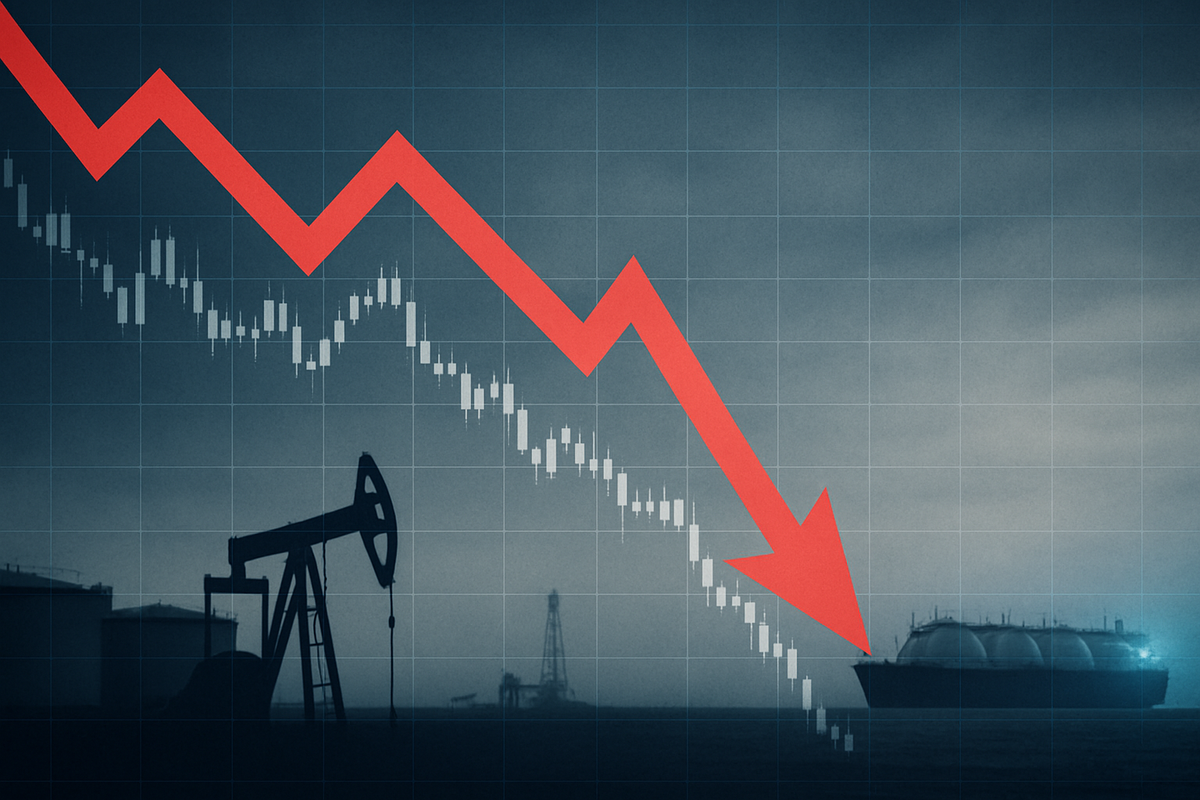
Calgary, AB – October 22, 2025 – Tourmaline Oil Corp. (OTCMKTS:TRMLF), a prominent player in the Canadian oil and gas sector, has seen its stock rating lowered by Zacks Research, shifting from a "hold" to a "strong sell." This significant downgrade, effective on or around October 22, 2025, reflects a growing bearish sentiment from Zacks, signaling anticipated underperformance for the company in the coming months. The move comes at a precarious time for the energy market, characterized by softening crude oil prices, a global supply surplus, and subdued demand, which are collectively exerting downward pressure on the sector.
The downgrade by Zacks Research immediately casts a shadow on Tourmaline Oil's near-term prospects, prompting investors to re-evaluate their positions. While the Canadian oil and gas industry has recently celebrated milestones such as increased export capacity and robust drilling activity, the broader commodity price outlook for crude oil remains challenging. This analytical revision from a respected research firm underscores the heightened sensitivity of energy stocks to prevailing market conditions and the critical importance of earnings estimates in driving investor confidence.
Detailed Coverage: Unpacking the Downgrade and Market Dynamics
Zacks Research's decision to reclassify Tourmaline Oil (OTCMKTS:TRMLF) to a "strong sell" is rooted in its proprietary quantitative stock-rating system, the Zacks Rank. The company now holds a "Zacks Rank 5," which represents the bottom 5% of stocks with the highest potential for underperformance relative to the broader market. Complementary "Style Scores" further illustrate Zacks' concerns, with Tourmaline receiving a "VGM Score" of "C," a "Value Score" of "D," a "Growth Score" of "A," and a "Momentum Score" of "F." These scores suggest that while the company may exhibit growth potential, it appears overvalued for value-focused investors and lacks positive short-term momentum.
The rationale behind Zacks' negative outlook extends beyond company-specific metrics, encompassing a broader industry-wide pessimism. The Canadian Oil & Gas - Exploration and Production industry is grappling with a negative earnings outlook, marked by significant downward revisions to earnings estimates for both 2025 and 2026. This challenging environment is exacerbated by "oil weakness, driven by U.S. tariffs and OPEC+ output hikes," which have constrained drilling activity and cash flows across the sector. Furthermore, a "downward revision in global demand forecasts and rising clean energy adoption add to long-term uncertainty" for the entire energy landscape.
Leading up to this downgrade, Tourmaline Oil had reported strong operational performance, including an 8% increase in Q1 2025 production and consistent free cash flow in Q2 2025. The company also pursued strategic acquisitions in the NEBC Montney region and announced a strategic shift towards unlocking greater liquids potential, particularly condensate, to drive margin expansion. However, despite these operational strengths and shareholder programs like renewed share repurchases and consistent dividends, the prevailing commodity price environment, with Brent crude declining 1.7% and WTI slipping to $62.33 per barrel by September 30, 2025, likely overshadowed these positive developments in Zacks' assessment. The global oil market has been in a significant surplus since early 2025, with projections indicating further inventory builds, placing sustained downward pressure on prices.
Market Implications: Potential Winners and Losers in a Volatile Landscape
The downgrade of Tourmaline Oil (OTCMKTS:TRMLF) by Zacks Research, set against a backdrop of volatile commodity markets, highlights the potential for a redistribution of fortunes within the energy sector. Companies heavily weighted towards crude oil production, particularly those with higher operating costs or significant debt burdens, are likely to face increased pressure. Tourmaline, despite its strategic shift towards liquids, remains exposed to crude price fluctuations, and a sustained period of lower prices could impact its profitability and investment appeal. Other oil-focused Canadian exploration and production companies may also see their valuations scrutinized more closely, potentially leading to further analyst downgrades or a general cooling of investor interest in this segment.
Conversely, the natural gas segment presents a more optimistic picture. Global natural gas demand, particularly for liquefied natural gas (LNG) exports, is experiencing strong growth. The impending commissioning of Canada's first major LNG export facility, LNG Canada, expected by July 2025, is a significant catalyst. This project will open new export routes to Asia, diversifying Canada's customer base beyond the United States and potentially revitalizing the natural gas segment. Therefore, companies with substantial natural gas assets and strong export capabilities, or those positioned to benefit from increased domestic demand for power generation, could emerge as relative winners. This includes companies like Tourmaline itself, given its significant natural gas operations, if its gas portfolio can offset weakness in its oil-weighted assets.
Furthermore, the challenging market conditions for oil-weighted assets could spur increased merger and acquisition (M&A) activity, particularly for natural gas assets. While U.S. oil and gas M&A activity slumped in Q3 2025 due to low crude prices, natural gas assets remain an area of interest. Well-capitalized companies with strong balance sheets might find opportunities to acquire distressed or undervalued assets, particularly in the gas sector, thereby consolidating market share and enhancing their long-term growth prospects. This scenario could lead to a strategic realignment within the industry, favoring those with financial flexibility and a clear focus on resilient commodity segments.
Wider Significance: Broader Trends and Future Outlook
The downgrade of Tourmaline Oil (OTCMKTS:TRMLF) by Zacks Research is more than an isolated event; it serves as a potent reflection of broader industry trends and the persistent challenges facing the global energy market. The overarching narrative for crude oil in October 2025 is one of oversupply and subdued demand. OPEC+ production increases, coupled with a global oil surplus of 1.9 million barrels per day (mb/d) since early 2025, are creating an environment of downward price pressure. This trend is further complicated by global demand growth forecasts remaining at a modest 700,000 bpd for both 2025 and 2026, a notable slowdown from previous years, attributed to high interest rates, economic uncertainties, and structural shifts towards cleaner energy.
These dynamics have significant ripple effects on competitors and partners within the Canadian oil and gas sector. While the commencement of the Trans Mountain Pipeline expansion in May 2024 and the nearing completion of LNG Canada offer robust export capacity and market diversification, the fundamental weakness in crude prices can still weigh heavily on producers. Companies with similar asset portfolios to Tourmaline, particularly those with a higher leverage to crude oil, may face similar scrutiny from analysts and investors. The financial pressures are evident, with major international oil companies reportedly needing crude prices above $80 per barrel to sustain current dividend and share buyback levels, a threshold significantly higher than current WTI prices.
Regulatory and policy implications continue to play a crucial role. Government programs, including tax incentives and carbon taxes, influenced the sector in 2024, but 2025 is expected to see a greater impact from external variables such as trade policies, geopolitical events, and market access. The ongoing global push for carbon reduction projects and the increasing adoption of clean energy further add to the long-term uncertainty for fossil fuel producers. Historically, periods of commodity price weakness have often led to industry consolidation, increased focus on cost efficiencies, and strategic shifts towards more resilient energy sources or geographies. This current environment could serve as another such inflection point, pushing companies to adapt their strategies more aggressively.
What Comes Next: Navigating the Evolving Energy Landscape
In the short term, the "strong sell" rating from Zacks Research is likely to exert continued downward pressure on Tourmaline Oil's (OTCMKTS:TRMLF) stock price. Investors will be closely watching for any further analyst revisions, as well as the company's next earnings reports for signs of how it is managing the challenging commodity price environment and executing its strategic shift towards liquids. The divergence in analyst opinions – with Goldman Sachs initiating a "Buy" rating and other firms like Raymond James Financial and TD Securities lowering to "Hold," while a consensus from multiple sources still points to a "Buy" – indicates significant market uncertainty and a battle of narratives regarding Tourmaline's future.
Looking further ahead, the long-term possibilities for Tourmaline and the broader Canadian energy sector will largely hinge on the trajectory of global commodity prices and the success of strategic adaptations. If crude oil prices remain subdued due to persistent oversupply and weak demand, oil-weighted producers will need to prioritize cost efficiencies, optimize capital allocation, and potentially divest non-core assets. For Tourmaline, its emphasis on unlocking greater liquids potential, particularly condensate, and its strong natural gas portfolio could serve as crucial buffers against crude oil volatility, but the execution of these strategies will be paramount.
Market opportunities may emerge in the natural gas sector, particularly with the full operationalization of LNG Canada. Companies well-positioned to capitalize on increased LNG exports to Asia could see enhanced profitability and investor interest. This could lead to a strategic pivot for some oil-focused producers to increase their natural gas exposure or for M&A activity to concentrate on gas-weighted assets. The challenges, however, remain significant for oil-weighted producers, who face not only commodity price headwinds but also increasing pressure from environmental, social, and governance (ESG) considerations and the ongoing global energy transition. Potential scenarios range from a continued period of volatility and consolidation to a gradual recovery if global economic growth accelerates and demand for energy picks up, or if geopolitical events significantly disrupt supply.
Comprehensive Wrap-Up: Assessing the Path Forward
The downgrade of Tourmaline Oil (OTCMKTS:TRMLF) to a "strong sell" by Zacks Research serves as a critical indicator of the prevailing headwinds in the global oil market as of October 2025. While Tourmaline has demonstrated operational resilience and strategic foresight with its shift towards liquids and robust natural gas assets, the market's current assessment, particularly from Zacks, highlights the significant impact of softening crude prices, supply surpluses, and a generally subdued demand outlook. The divergence in analyst ratings underscores the complexity and uncertainty facing investors in the energy sector, where company-specific strengths must be weighed against broader macroeconomic and commodity market dynamics.
Moving forward, the market will likely remain highly sensitive to global oil and gas price trends, OPEC+ production decisions, and evolving geopolitical landscapes. For Tourmaline and its peers, the ability to maintain strong operational efficiency, manage capital effectively, and adapt to changing energy demands will be crucial. The natural gas segment, buoyed by strong LNG export prospects, offers a potential area of strength that could partially offset weaknesses in the crude oil market.
Investors should closely monitor several key factors in the coming months: crude oil and natural gas price movements, Tourmaline's upcoming financial reports and operational updates, any further revisions in analyst ratings, and the broader economic indicators that influence global energy demand. The long-term significance of this downgrade lies in its reflection of a market undergoing a fundamental shift, where traditional oil and gas companies must navigate increasing volatility and strategically position themselves for a future increasingly shaped by energy transition and diversified commodity portfolios.
This content is intended for informational purposes only and is not financial advice





